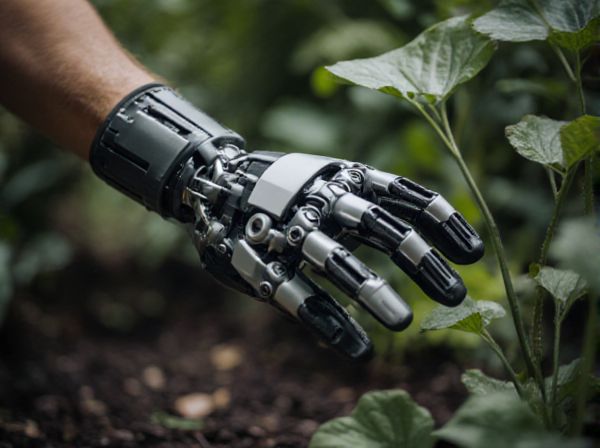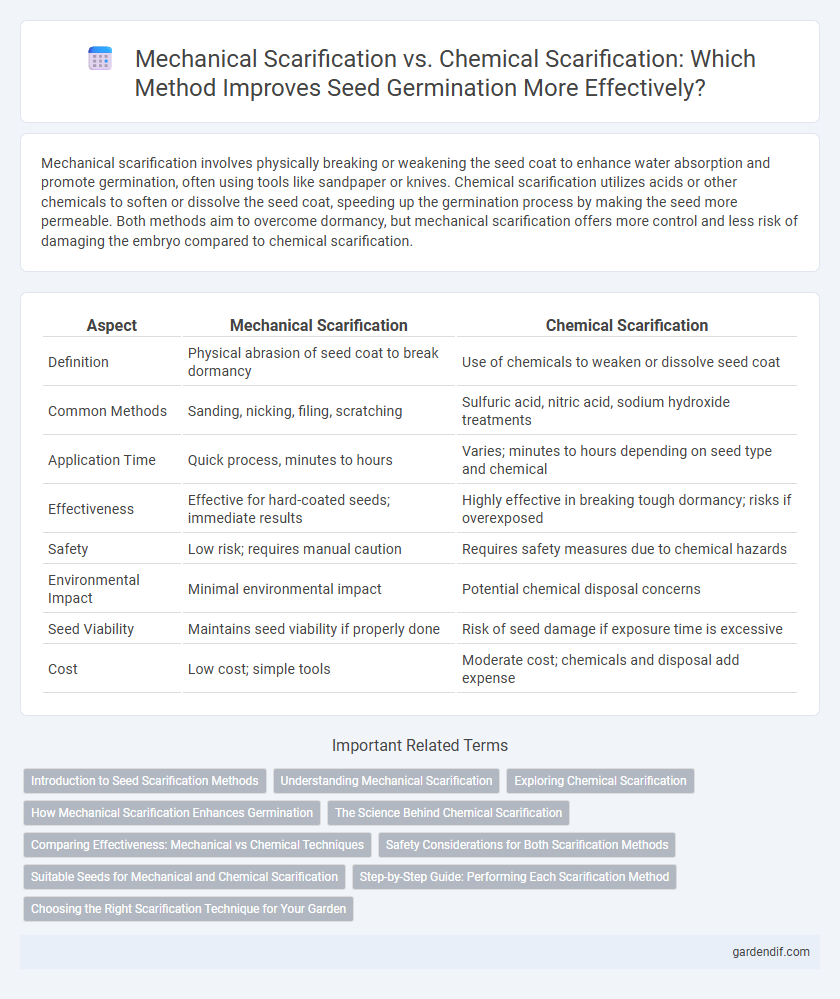
Mechanical scarification vs Chemical scarification Illustration
Mechanical scarification involves physically breaking or weakening the seed coat to enhance water absorption and promote germination, often using tools like sandpaper or knives. Chemical scarification utilizes acids or other chemicals to soften or dissolve the seed coat, speeding up the germination process by making the seed more permeable. Both methods aim to overcome dormancy, but mechanical scarification offers more control and less risk of damaging the embryo compared to chemical scarification.
Table of Comparison
| Aspect | Mechanical Scarification | Chemical Scarification |
|---|---|---|
| Definition | Physical abrasion of seed coat to break dormancy | Use of chemicals to weaken or dissolve seed coat |
| Common Methods | Sanding, nicking, filing, scratching | Sulfuric acid, nitric acid, sodium hydroxide treatments |
| Application Time | Quick process, minutes to hours | Varies; minutes to hours depending on seed type and chemical |
| Effectiveness | Effective for hard-coated seeds; immediate results | Highly effective in breaking tough dormancy; risks if overexposed |
| Safety | Low risk; requires manual caution | Requires safety measures due to chemical hazards |
| Environmental Impact | Minimal environmental impact | Potential chemical disposal concerns |
| Seed Viability | Maintains seed viability if properly done | Risk of seed damage if exposure time is excessive |
| Cost | Low cost; simple tools | Moderate cost; chemicals and disposal add expense |
Introduction to Seed Scarification Methods
Mechanical scarification involves physically breaking or weakening the seed coat using methods such as sanding, nicking, or cracking to enhance water absorption and promote germination. Chemical scarification uses acids or other chemicals, like sulfuric acid, to dissolve or soften the seed coat, facilitating embryo emergence. Both techniques address seed dormancy caused by impermeable seed coats, improving germination rates in hard-coated seeds.
Understanding Mechanical Scarification
Mechanical scarification involves physically breaking or weakening the seed coat to enhance water absorption and facilitate germination, especially for hard-coated seeds like legumes and certain tree species. Common techniques include nicking with a blade, sanding, or using abrasive materials to create micro-abrasions, improving permeability. This method is favored for its simplicity, cost-effectiveness, and minimal chemical use compared to chemical scarification, which involves treating seeds with acids or other chemicals to achieve similar results.
Exploring Chemical Scarification
Chemical scarification uses acids such as sulfuric acid or nitric acid to break seed coats, enhancing water uptake and accelerating germination rates for hard seeds like legumes and certain tree species. This method provides precise control over exposure time and concentration, reducing physical damage compared to mechanical scarification techniques like nicking or sanding. By effectively softening impermeable seed coats, chemical scarification improves seedling uniformity and vigor in agricultural and reforestation projects.
How Mechanical Scarification Enhances Germination
Mechanical scarification enhances germination by physically breaking or weakening the seed coat, allowing water and oxygen to penetrate more easily, which speeds up the metabolic processes necessary for seed growth. Techniques such as sanding, nicking, or abrading create microfractures in the seed coat that overcome dormancy barriers, improving germination rates and uniformity. This method is preferred for hard-coated seeds like legumes and certain tree species, where chemical scarification might risk seed damage or require hazardous substances.
The Science Behind Chemical Scarification
Chemical scarification involves using acids or other chemicals to break down the hard seed coat, facilitating water absorption and oxygen exchange essential for germination. The science behind this method relies on softening or partially dissolving the seed coat's lignin and cellulose structures, replicating natural processes such as passage through an animal's digestive tract. This targeted seed coat modification accelerates germination rates and enhances seedling vigor by overcoming physical dormancy barriers.
Comparing Effectiveness: Mechanical vs Chemical Techniques
Mechanical scarification involves physically breaking seed coats using methods such as sanding or nicking, providing immediate permeability and often faster germination rates for hard-coated seeds. Chemical scarification uses acids like sulfuric acid to dissolve the seed coat, which can be more uniform but requires careful timing to avoid seed damage. Studies show mechanical scarification is more effective for seeds with extremely hard coats, while chemical scarification suits seeds needing controlled weakening of the seed coat to enhance water absorption.
Safety Considerations for Both Scarification Methods
Mechanical scarification involves physically breaking seed coats using tools like sandpaper or knives, which poses minimal chemical risk but requires caution to avoid injury from sharp instruments. Chemical scarification uses acids like sulfuric acid to weaken seed coats, demanding strict safety protocols including protective gloves, goggles, and proper ventilation due to the hazardous nature of the chemicals. Both methods require awareness of potential risks, with mechanical scarification focusing on physical safety and chemical scarification necessitating chemical hazard management to ensure safe handling and effective germination.
Suitable Seeds for Mechanical and Chemical Scarification
Mechanical scarification is suitable for seeds with hard, impermeable seed coats such as those from legumes, acacia, and morning glory, where physical abrasion helps water penetration. Chemical scarification works effectively on seeds like tamarind, mesquite, and some tree species with tough coats by using acids to weaken the seed coat and promote germination. Both methods are chosen based on seed coat thickness and species-specific dormancy mechanisms to optimize germination success.
Step-by-Step Guide: Performing Each Scarification Method
Mechanical scarification involves carefully nicking or sanding the seed coat using a file, sandpaper, or knife to enhance water absorption, followed by soaking the seed in water for 12-24 hours to trigger germination. Chemical scarification requires immersing seeds in concentrated sulfuric acid for a precise duration, usually between 10 to 30 minutes depending on seed hardness, followed by thorough rinsing with water to remove acid residues before planting. Both methods improve seed coat permeability but require careful timing and handling to avoid damaging the embryo and ensure successful germination.
Choosing the Right Scarification Technique for Your Garden
Mechanical scarification uses physical methods like abrasion or nicking to break seed coats, ideal for hard seeds such as legumes and morning glories, promoting water absorption and faster germination. Chemical scarification employs acids or other chemicals to weaken tough seed coats, effective for species like mesquite and acacia, but requires careful handling to avoid seed damage. Selecting the appropriate scarification technique depends on seed type, safety considerations, and available resources to optimize germination rates in your garden.
Mechanical scarification vs Chemical scarification Infographic

 gardendif.com
gardendif.com